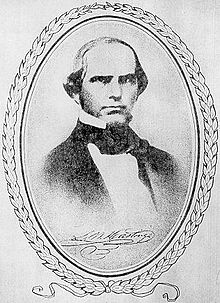Lansford W. Hastings
| Lansford Hastings | |
|---|---|
 |
|
| Born |
Lansford Warren Hastings 1819 Mount Vernon, Ohio |
| Died | 1870 St. Thomas, Virgin Islands |
| Occupation | lawyer, writer and adventurer |
| Known for | developer of the Hastings Cutoff |
| Spouse(s) | Charlotte Toler |
Lansford Warren Hastings (1819–1870) is best remembered as the developer of Hastings Cutoff, a shortcut across what is now the state of Utah, a factor in the Donner Party disaster of 1846. He was a Major in the Confederate States Army during the American Civil War.
Born to Dr. Waitstill and Lucinda (Wood) Hastings in Mount Vernon, Ohio, he was a descendant of Thomas Hastings who came from East Anglia in England to the Massachusetts Bay Colony in 1634. Hastings was trained as a lawyer. In 1842, he traveled overland to Oregon. While there, he briefly represented Dr. John McLoughlin, preparing his land claim near Willamette Falls and surveying Oregon City, Oregon (which would become the first incorporated city west of the Rocky Mountains). He left in the spring of 1843 for Alta California, a sparsely populated province of Mexico. By the time he returned to the United States in 1844, he had decided to help to wrest California from Mexico and establish an independent Republic of California, with himself holding high office.
Hastings wrote The Emigrants' Guide to Oregon and California to induce Americans to move to California, hoping they could effect a bloodless revolution by sheer numbers. He described California in glowing terms and gave practical advice to overland travelers. Contrary to popular belief, he did not promote the cutoff that bears his name in his book. He merely described it in a single sentence as a possible route: "The most direct path would be leave the Oregon route, about two hundred miles east of Fort Hall; thence bearing west-south west, to the Salt Lake; and thence continuing down to the bay of San Francisco." (Hastings, pp. 137–138). However, Hastings wrote this statement before he had traveled the route himself, and he may have been unaware of the difficulties in crossing the Wasatch Range and the salt flats of western Utah.
...
Wikipedia
